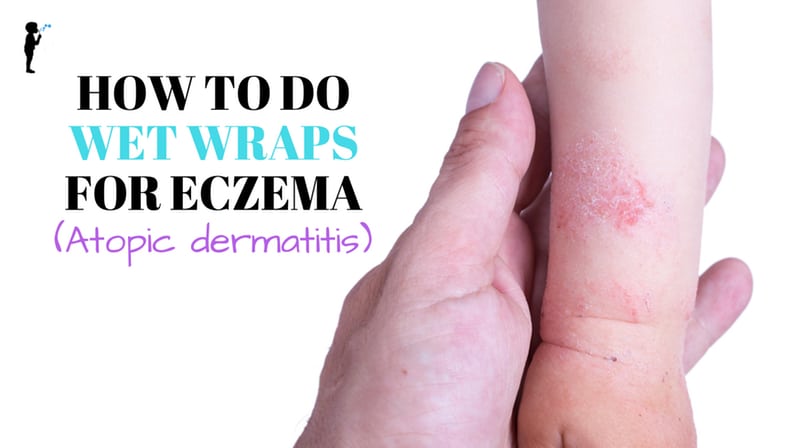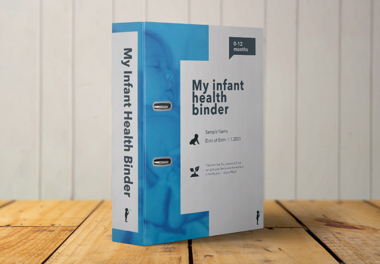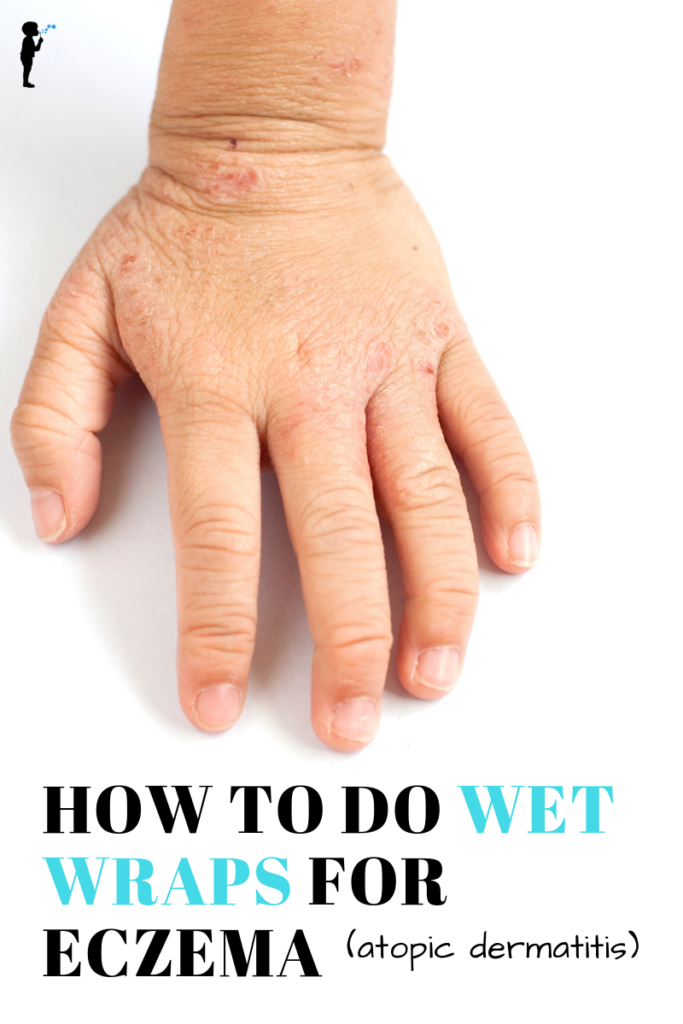
How to do wet wraps for eczema (atopic dermatitis)
- 4 ways your child may not tolerate cow’s dairy: allergy, milk protein sensitivity, cerebral folate deficiency, and lactose intolerance - January 3, 2024
- 5-hydroxytryptophan (5-HTP) and the “feel good” neurotransmitter serotonin - October 4, 2023
- Quercetin supplementation for children: research, safety and efficacy - May 13, 2023
It sounds weird, it feels strange, but of all the options for severe eczema treatment my favorite is wet wraps! Do you know how to do wet wraps for your child with eczema?
What is eczema?
Eczema is also called atopic dermatitis. It is a red, scaly rash that is intensely itchy. Most kids who develop eczema get their first rash under the age of 5. (Often kids get eczema when they are still babies.) In my office I usually see kids develop eczema somewhere around 4 months of age, with it progressively worsening in the first year of life. By age 2-3, however, many (but not all!) kids are starting to outgrow their eczema and food allergies or sensitivities.
When to use wet wraps for your child’s eczema
In my office I typically start with some very simple supplements and dietary changes to help heal eczema from the inside out. I list several in my article Allergies, asthma and eczema: The Th1/Th2 story
If these simple supplements are not helping, or if the child’s eczema is severe to the point of scratching nightly then I will typically recommend the family to start wet wraps as well.

Why wet wraps? (That sounds gross…)
One of the main issues with eczema is that the skin loses its ability to retain moisture. When the skin dries out severely then it leaves tiny cracks or breaks in the skin, which makes the skin more susceptible to infection.
In the past we used to recommend children to avoid bathing because soaps strip the skin of natural oils, making eczema worse. Now the recommendations have changed, we now recommend kids to bathe daily or even up to four times daily to rehydrate the skin. Wet wraps after the bath help seal and lock in the moisture so the skin has a chance to heal naturally before it begins to “crack” and dry out again.
How to do wet wraps for eczema
1. Have your child soak in warm (but not too hot!) bath water for at least 15 minutes.
Do NOT use detergent-containing soaps. In fact we recommend using NO soap until you can find a hypoallergenic, mild moisture-rich soap that your child does not react to. Be aware that when eczema becomes severe some children will begin to react to many or all plant-based products. For now it is best to skip the soap all together. If the child has eczema on his/her head then periodically pour warm water over the head or put a wet washcloth on the head to increase moisture to the affected area. Disinfect the bath and bath toys frequently to avoid spreading infection!
2. Help your child out of the bath and gently towel dry.
Use a clean, dry towel and a gentle patting motion. Make sure you keep those towels clean by washing them often (2+ times per week) in hot water and hypoallergenic, unscented laundry detergent or other laundry soap. For more information about detergent sensitivity see SolveEczema.org.
3. If your child has been prescribed a topical steroid or compounded medication apply this quickly only to the severely affected areas.
(Your child’s doctor will tell you which areas really need it.) Next week we’ll share our article about when/why children should use a topical steroid. (Hint: only when it’s severe!)
4. Immediately apply topical barrier moisturizer to the rest of your child’s skin.
Your child’s physician should be able to help you decide on which topical barrier cream, ointment or salve is best for your child. My favorite “natural” cream is Weleda White Mallow Lotion. But be aware that some children react to even this lotion, and will need to use a hypoallergenic petroleum-based product instead, like Vanicream or Aquafor. (Yes, yes, I know, petroleum products are NOT natural! But for some kids it is literally the only option.) Try to make sure you get your child lathered in moisturizer within minutes of getting out of the bath. Use a thick layer of moisturizer and don’t bother to rub it in all the way. You should be able to visibly see the lotion as a thick layer on the skin. Do NOT use moisturizer over the topical steroid or compounded medication (which would probably spread the steroid around and/or dilute it).
5. Keep the moisturizers / creams / lotions clean!
If you are using a tub (e.g., Vanicream) always use a clean spoon to scoop out ointment. Do NOT use your fingers in the tub! Do NOT double dip! This prevents the spread of infection to healthy skin.
6. Apply antibiotic/antifungal medication to infected areas last (if needed).
7. Soak 100% cotton clothes in warm water.
For children with widespread eczema you can use fitted pajamas. For children with eczema only on their hand or feet or small affected areas you can use 100% cotton socks, gloves, gauze or strips of cloth. Wring out the excess water (so it is damp) and apply the damp clothes or help your child into the wet pajamas. Kids hate this step, I know! Heavily bribe or encourage them with sticker charts for rewards, or screen/tablet time (which is a great motivator for a lot of kids). https://www.adrescuewear.com/ sells wet wrap pajamas if you have a hard time finding some near you.
8. Immediately cover the wet layer with a dry layer.
Many parents use fleece or flannel footsie pajamas to completely cover their child.
9. Keep your child in the wet wraps for at least 1 hour, preferably overnight. Keep your child warm!
How often? How long?
Wet wraps work best when you apply them daily (nightly preferably). Yes, I know, I know, some kids really hate them! If you can’t get them to stay in it overnight then I recommend doing wet wraps in the morning or mid-day and then keeping them in it as long as possible. Sometimes kids will be distracted by toys or screen time. (I don’t love screen time for young kids, but if eczema is really severe and this is the only way to get them to keep the wraps on for an hour then it’s worth it!)
Eczema typically gets better within 2 weeks of regular use. Keep it going as long as possible! Some parents will be able to reduce the frequency of the wet wraps to a few times per week as “maintenance” therapy.
Final notes
If your child is using topical steroids to manage his/her eczema please be aware that they may get rebound eczema if you abruptly discontinue them. Many times wet wraps make the eczema so much better that parents stop the steroids all at once and are then surprised when the wet wraps suddenly “stop working.” I highly recommend slowly discontinuing topical steroids over the course of weeks rather than stopping all at once. Your child’s doctor should be able to help you figure out a way to “wean” off of topical steroids.









